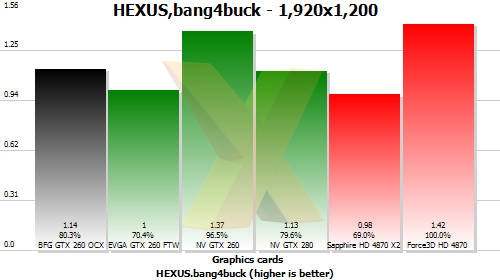HEXUS.bang4buck
In a rough-and-ready assessment of the cards' bang per buck, we've aggregated the 1,920x1,200 frame-rates for the four games, normalised them* and taken account of the cards' prices.
But there are more provisos than we'd care to shake a stick at. We could have chosen four different games, the cards' prices could have been derived from other sources and pricing tends to fluctuate daily.
Consequently, the table and graph below highlight a metric that should only be used as a yardstick for evaluating comparative performance with price factored in. Other architectural benefits are not covered, obviously.
| Graphics cards | BFG GTX 260 OCX 896MB | EVGA GTX 260 FTW 896MB | Leadtek GTX 260 896MB | Leadtek GTX 280 1GB | Sapphire HD 4870 X2 2GB | Force3D HD 4870 512MB |
|---|---|---|---|---|---|---|
| Actual aggregate marks at 1,920x1,200 | 275.43 |
276.42 | 247.85 |
301.82 |
434.95 |
261.86 |
| Aggregate marks, normalised*, at 1,920x1,200 | 257.72 |
258.21 |
239.78 |
270.91 |
337.48 |
240.83 |
| Current pricing, including VAT | £225.69 | £258.50 | £175.06 | £240.86 | £345 | £170 |
| HEXUS.bang4buck score at 1,9200x1,200 | 1.14 |
1.00 |
1.37 |
1.13 |
0.98 |
1.42 |
| Acceptable frame rate (av. 60fps) at 1,920x1,200 | Yes | Yes | No (COH:OF, COD4, GRID) | Yes | Yes |
No (COH:OF) |
* the normalisation refers to taking playable frame rate into account. Should a card benchmark at over 60 frames per second in any one game, the extra fps count as half. Similarly, should a card benchmark lower, say at 40fps, we deduct half the difference from its average frame rate and the desired 60fps, giving it a HEXUS.bang4buck score of 30 marks. The minimum allowable frame rate is 20fps but that scores zero.
As an example, should a card score 120fps we treat it as 90fps as only half the frame rate above 60fps is counted for the HEXUS.bang4buck - this is the formula: (120-((120-60)/2)). Similarly, should it score 30fps, we count it as only 15fps: (30+((30-60)/2)).
The reasoning behind such calculation lies with playable frame rates.
Should card A score 110fps in a benchmark and card B 160, then card B would otherwise receive an extra 50 marks in our HEXUS.bang4buck assessment, even though both cards produce perfectly playable frame rates and anything above 60fps is a bonus and not a necessity for most.
Similarly, without our adjustments, the aggregated HEXUS.bang4buck total for two very different cards would be identical if, in a further benchmark, card A scored a smooth 70fps and card B an unplayable 20fps. Both would win marks totally 180, yet the games-playing experience would be vastly different.
A more realistic (and useful) assessment would say that card A is better because it ran smoothly in both games - and that view would be accurately reflected in our adjusted aggregation, where card A would receive 150 marks (85+65) and card B 100 (100+0).
In effect, we're including a desired average frame rate, in this case 60, and penalising lower performance while giving frame rates higher than 60fps only half as much credit as those up to 60fps. If this doesn't make sense or you have issue with it, please hit the HEXUS community.
Here's the HEXUS.bang4buck graph at 1,920x1,200. The graph divides the normalised score by the price.

The graphical manifestation of the HEXUS.bang4buck metric shows that the BFG's near-identical performance to the EVGA card leads to a better HEXUS.bang4buck - solely through a lower street price.
However, 'better' value is still to be had with a stock-clocked card, and we'd also look towards recommending the cheapest GeForce GTX 280, because it will naturally have more frequency headroom.
Convoluting matters further, the Radeon HD 4870 is a decent bet, too, with excellent performance for £170. In fact, there really is no bad card in this six-SKU line-up.









